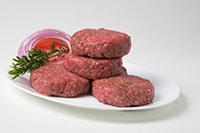Restaurant Traits Linked with Safer Ground Beef Preparation and Cooking Practices
EHS-Net Recommends
Restaurant management should support kitchen staff in efforts to become food safety certified.
Food-safety programs should develop measures to improve ground beef practices. These measures should focus on independent and sit-down restaurants.

Why This Study Was Done
E. coli, a germ often found in raw ground beef, causes many foodborne illnesses each year. Hamburgers made from ground beef are often the source of these germs. These germs can make people sick if hamburgers are undercooked (not cooked to a high enough temperature to kill the germs). These germs can also make people sick if they get into other food or onto other surfaces (cross contamination).
We don’t know much about why some restaurants prepare and cook ground beef more safely than others. If we know more about differences between these restaurants, we can focus improvement programs accordingly.
Cooking of Ground Beef
The FDA Food Code says that restaurants should cook ground beef to 155°F for 15 seconds. But CDC and USDA say that consumers should cook ground beef to 160°F. The guidance for consumers is different because it is simpler to meet one standard (temperature) than two (temperature and time). Cooking ground beef to 160°F kills E. coli germs rapidly.
What the Study Described
The purpose of this study was to describe traits of restaurants linked to safe ground beef practices. We focused on whether restaurant workers
- Used a thermometer to be sure raw ground beef was not undercooked. Hamburgers cooked rare or medium-rare are undercooked.
- Prevented cross contamination of raw ground beef and other foods or utensils. This can happen when hands or equipment touch raw ground beef and then touch other food or equipment.
What the Study Found
EHS-Net found that chain restaurants and restaurants with food safety certified kitchen managers (CKMs) may have safer ground beef practices than other restaurants.
Safer ground beef practices in chain restaurants compared to independent restaurants include the following:
- Managers in chain restaurants
- Were more likely to say that they take the final temperature of hamburgers with a thermometer.
- Were less likely to say that they serve rare or medium-rare hamburgers, even if customers ask for it. Rare or medium-rare hamburgers are undercooked.
- Workers in chain restaurants
- Were less likely to wipe their hands on cloths or aprons after touching raw ground beef.
- Were less likely to use the same utensils on raw ground beef and other foods without washing between uses.
Safer ground beef practices in restaurants with CKMs compared to those without CKMs include the following:
Managers in restaurants with CKMs
- Were more likely to say that they take the final temperature of hamburgers with a thermometer.
- Were less likely to say that they serve rare or medium-rare hamburgers, even if customers ask for it.
- Certified kitchen manager: a restaurant manager that has passed a test about food safety.
- Chain restaurant: one with the same name and operations as other restaurants. Restaurants with the same name in many cities are chain restaurants.
- Cross contamination: spread of germs from one surface or food to another by contact.
- E. coli: germ that cause foodborne illness.
- Sit-down restaurant: restaurant where customers receive table service, rather than ordering at a counter
- Undercooked burger: a burger that is not cooked to the FDA recommended temperature of 155°F
Scientific article this plain language summary is based on: Ground Beef Handling and Cooking Practices in Restaurants in Eight States [PDF – 318 KB]
Other summaries related to certification:
- Food Safety Certification and Knowledge
- Kitchen Manager Certification Study and Food Safety
- Food Safety Differences Between Restaurants Linked and Not Linked to Outbreaks
Restaurant Manager and Worker Food Safety Certification Study (study information)
More EHS-Net publications by Study Topic
This study was conducted by the Environmental Health Specialists Network (EHS-Net). EHS-Net is a federally funded collaboration of federal, state, and local environmental health specialists and epidemiologists working to better understand the environmental causes of foodborne illness.